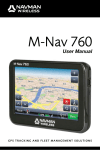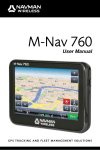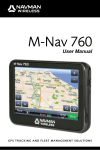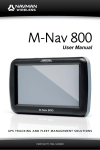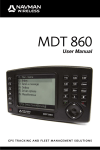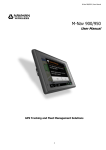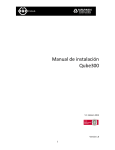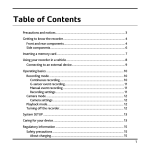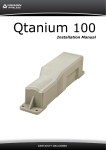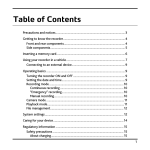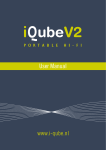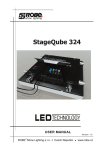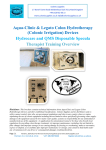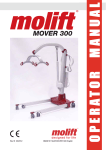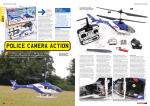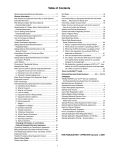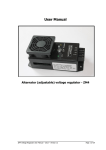Download M-Nav 750 | User Manual
Transcript
M-Nav 750 User Manual G P S T R A C K I N G A N D F L E E T M A N AG E M E N T S O L U T I O N S M-Nav 750 | User Manual Contents 1 Introduction . . . . . . . . . . . . . . . . . . . . . . . . . . . . . . . . . . . . . . . . . . . . 5 1.1 Important Safety Information 5 1.2 Disclaimer 5 1.3 Glossary of Terms 6 2 The M-Nav 750 . . . . . . . . . . . . . . . . . . . . . . . . . . . . . . . . . . . . . . . . . . 7 2.1 Box Contents 7 2.2 Optional Items 7 2.3 M-Nav 750 Parts 8 3 Install the M-Nav 750 in a Vehicle . . . . . . . . . . . . . . . . . . . . . . . . . . . . . . . 10 3.1 Assemble the Docking Cradle 10 3.2 Windscreen Installation 10 3.3 Add the M-Nav 750 to the docking cradle 11 4 Get Started . . . . . . . . . . . . . . . . . . . . . . . . . . . . . . . . . . . . . . . . . . . . 12 4.1 Language and Warning screens 12 4.2 Driver Logon & Status 13 4.3 Vehicle Inspection 13 4.4 Check the GPS Status 14 4.5 Check the Qube Tracking Device Status 15 4.6 Driver Logoff 16 5 Messages. . . . . . . . . . . . . . . . . . . . . . . . . . . . . . . . . . . . . . . . . . . . . 17 5.1 Types of Message 17 5.2 New Messages 17 5.3 Read a Stored Message 18 5.4 Reply with a Canned Template 19 5.5 Create a New Message / Reply 20 5.6 Delete a Message 21 5.7 Show a Message Location 21 5.8 Go to a Message Location 22 6 Navigation Basics . . . . . . . . . . . . . . . . . . . . . . . . . . . . . . . . . . . . . . . . 23 6.1 Display & Move the Map 23 6.2 Map Icons 23 6.3 Navigation Icons 24 6.4 Mute or Set the Volume 25 6.5 Night-Time Navigation 26 6.6 How to Enter Data & Remove Errors 27 3 M-Nav 750 | User Manual 7 Find and Go to a Location . . . . . . . . . . . . . . . . . . . . . . . . . . . . . . . . . . . . 28 7.1 Find a Street Address 28 7.2 Find a Postal Code 29 7.3 Find Other Types of Location 30 7.4 Navigate to Destination From Your Location 31 7.5 Set Location as Home 32 7.6 Find a POI 33 7.7 Set a Location as a Favourite Place 34 8 Plan a Route . . . . . . . . . . . . . . . . . . . . . . . . . . . . . . . . . . . . . . . . . . . 35 8.1 Plan a Route from Any Location 35 8.2 Add a Location as a Via Point 36 8.3 Show / Add Places Along the Route 37 8.4 Optimise / Change the Order of the Via Points 38 8.5 Save a Route 38 8.6 Add a Detour to Avoid an Area 39 8.7 Use a Saved Route 39 8.8 Delete a Saved Route 40 8.9 Delete a Route 40 9 Route Information . . . . . . . . . . . . . . . . . . . . . . . . . . . . . . . . . . . . . . . . 41 9.1 Show an Overview of this Route 41 9.2 Demonstrate this Route 41 9.3 Show Total Time & Distance 42 9.4 Show all Manoeuvres on the Route 42 10 Set Your Preferences . . . . . . . . . . . . . . . . . . . . . . . . . . . . . . . . . . . . . . 43 10.1 Set Route Type & Vehicle Type 43 10.2 Set Truck Attributes 44 10.3 Set Road Types to Avoid 45 10.4 Set Road Types to Exclude 46 10.5 Set Distance Units 46 10.6 Set Date / Time Formats 47 10.7 Set Geographic / Custom Time Zone 48 10.8 Set Language 49 10.9 Set the Choose Language at Startup Option 50 10.10 Restore Factory Default Settings 51 4 M-Nav 750 | User Manual 1 Introduction Thank you for purchasing the Navman Wireless M-Nav 750 messaging and navigation device. We hope you enjoy using it. It has been carefully designed so it is easy to install, setup, and use. You can: • use the navigation option to search for locations such as a street address, a postal code, or a city centre • set a location as the start point, a via point, or the destination • have the M-Nav 750 calculate the route then guide you along it with clear visual and verbal instructions • check for places and points of interest such as fuel stops, nearby or along your route. • add stops (via points) to your route • use the message option to receive messages from, and send messages to, your fleet administrator • navigate directly to a location specified in a message from your fleet administrator • use the setup option to customise the M-Nav 750 to suit your own preferences 1.1 Important Safety Information Do NOT mount the M-Nav 750 where it obstructs the driver’s view or may distract the driver. DO NOT mount the M-Nav 750 where it may interfere with the safe operation of the vehicle or the deployment of airbags or other safety equipment. Consult the vehicle manual to ensure the mounting location is safe, if necessary. Do NOT enter navigation data or other information into the M-Nav 750 while you are driving. Comply with these safety instructions at all times. Failure to comply with these safety instructions may lead to accidents, personal injury including death, property damage or violation of the law. 1.2 Disclaimer Navman Wireless disclaims all liability for installation and use of this product in a way that contributes to injuries, death, property damage or violation of the law. The user of this product is solely responsible for observing safe driving practices and for all use of this device. It is the user’s responsibility to operate the M-Nav 750 in accordance with the law. This M-Nav 750 provides route information for guidance only. Accordingly it is your sole responsibility to consider the height, weight, length or Hazmat classification of your vehicle and to ensure that it is legally and physically able to travel over routes that may include narrow, twisting or steep roads; weak, narrow or low bridges; tunnels or other obstacles on the route determined by this M-Nav 750. This manual represents the M-Nav 750 at the time of printing. Navman Wireless reserves the right to make changes to specifications without notice. 5 M-Nav 750 | User Manual 1.3 Glossary of Terms Common terms used in this manual and on the M-Nav 750 include: GPS The GPS is a network of satellites that orbit the Earth at about 19,300 kms (12,000 miles) and transmit accurate time and position information worldwide. The GPS receiver in your M-Nav 750 picks up signals from any satellites in view and uses the information to determine your location, accurate to within 5 m (15 ft). Usually, only three signals are needed to provide a latitude and longitude position (GPS fix) for vehicle navigation systems. POI Point of Interest. This is a useful resource along or nearby the route, such as a fuel location or a post office. You can add a POI to your route as a via point. Via Point A specific location that you want to visit along the route. A via point can be any location that you specify, such as a customer site, or a POI. Destination The next via point along your route. Final Destination The final via point along your route. It is always marked with a chequered flag. Trip The complete list of via points that you specify; including the start location, the final destination, and any via points between. Route When you have defined all the via points in your trip, the M-Nav 750 will calculate the best route automatically after it obtains a GPS fix. Your route shows the path to drive. Only one route can be shown on the map at a time. 6 M-Nav 750 | User Manual 2 The M-Nav 750 2.1 Box Contents The M-Nav 750 is supplied with a suction mount designed for installation on a vehicle windscreen. (If you do not want to mount the M-Nav 750 on the windscreen, use the optional Permanent Installation Kit.) Check that you have ALL of these items before you start the installation. Contact your supplier if anything is missing. Alcohol swab M-Nav 750 device RJ-45 cable Suction mount Cradle fixture (serial connection view) 2.2 Optional Items An optional Permanent Installation Kit enables you to install the M-Nav 750 onto any hard surface, such as the top of the dashboard, which has a good view of the sky. Contact your supplier for more information. An optional External GPS Antenna can be connected to your M-Nav 750. This can be used to receive the GPS signal (instead of the internal GPS antenna already built into the M-Nav 750) and means that you can install the M-Nav 750 anywhere in the vehicle. Contact your supplier for more information. 7 M-Nav 750 | User Manual 2.3 M-Nav 750 Parts Familiarise yourself with the parts of your M-Nav 750 before starting the installation. 1 4 6 7 8 2 3 5 9 10 11 12 13 14 15 16 8 M-Nav 750 | User Manual Component Description 1 External GPS antenna connector Connector is located under the black dust cap. Use only if you have purchased an optional external GPS antenna (see Section 2.2). 2 Jack point Headset connection point (optional). 3 Mini USB port External connection port (not used). 4 SD card Contains the maps for the navigation feature. 5 Reset button Restart the M-Nav 750 during the upgrade process. 6 Standby button Press to toggle the M-Nav 750 between operating and standby state. When the M-Nav 750 is in standby state and the screen is blank, just press the standby button to re-display the most recent screen. (Note: if the M-Nav 750 internal battery has discharged the splash screen will be displayed instead). 7 Hot button Press to return to the Main Menu. 8 Internal GPS antenna Approximate position of the internal GPS antenna that is built into the M-Nav 750 and is not visible to view. 9 Not in use Not applicable. 10 LED Battery status. LED glows red when battery is charging. 11 Screen Displays menus, maps and messages. 12 Microphone Not used in M-Nav 750. 13 Light sensor Automatically helps to adjust the screen brightness to a suitable level for the current lighting conditions. 14 Speaker Provides system sounds and navigational voice prompts. 15 ON/OFF switch Switch the internal battery ON or OFF. Usually switched ON. 16 4-pin serial connection When the M-Nav 750 is in its cradle, this serial connection provides external power and data from the Qube tracking device. LED glows green when battery is charged. 9 M-Nav 750 | User Manual 3 Install the M-Nav 750 in a Vehicle Note: These installation instructions assume that the Qube tracking device is already installed in the vehicle and that the RJ-45 cable has been fed through the dashboard, ready for connection to the M-Nav 750. When you have assembled the docking cradle, you can either: • use the suction mount to attach the M-Nav 750 to the vehicle windscreen, or • use the optional hard installation kit to attach the M-Nav 750 to a hard surface, such as the top of the dashboard 3.1 Assemble the Docking Cradle Connect the suction mount to the cradle fixture, as shown, to form the docking cradle. 1. Connect the suction mount to the docking cradle here. 3.2 2. Slide the suction mount to the right so that it clicks into place under this clip. Windscreen Installation Note: Some windscreens contain areas of tinted glass that may interfere with the GPS signal. Do not mount the M-Nav 750 in these areas. Read the Important Safety Information in Section 1.1. Decide where to locate the suction mount on the windscreen. Use the alcohol swab to thoroughly clean that area of the windscreen, then dry the area with a soft, lint-free cloth. Press the suction cup (part of the docking cradle) firmly against the windscreen for 3 seconds. Push the lever down to vacuum-seal the suction cup to the windscreen. Now you are ready to add the M-Nav 750 to the docking cradle. See Section 3.3. 10 M-Nav 750 | User Manual 3.3 Add the M-Nav 750 to the docking cradle IMPORTANT: Check the M-NAV 750 internal battery switch is ON before you add the M-Nav 750 to the docking cradle. You should not need to touch this switch again after it has been switched ON. Insert the RJ-45 cable (already fed through the dashboard from the Qube tracking device) into the RJ-45 connection socket at the back of the docking cradle. Put the bottom of the M-Nav 750 into the docking cradle, and then push the M-Nav 750 gently back until it snaps into place with an audible click. IMPORTANT: The M-Nav 750 must be in the docking cradle and connected to the Qube tracking device in order for you to report your driver status, send and receive messages and otherwise communicate with your fleet administrator through the OnlineAVL2 application. The start up screen will display automatically. See Section 4. Adjust the angle of the M-Nav 750 using the pivot screw on the docking cradle to give a comfortable viewing position. Note: If you are leaving the vehicle for a while, we recommended that you remove the M-Nav 750 from the docking cradle and store it in a safe place. 11 M-Nav 750 | User Manual 4 Get Started 4.1 Language and Warning screens Note: The following sequence of screens will appear the FIRST time that you use your M-Nav 750, OR whenever the internal battery in the M-Nav 750 has gone flat (this can happen if you have not used your M-Nav 750 for several days). Otherwise, your M-Nav 750 will re-display the last screen that you used. The loading bar will appear on the screen while the software is loading into your M-Nav 750. When the loading bar disappears, your M-Nav 750 is ready for use. If this ‘Settings’ screen appears after the splash screen, just touch the language you want to use, then touch Accept. Note: You can configure your M-Nav to choose this language automatically at start up (see Section 10.9). Note: The country map is loaded automatically and is independent of the language that you select here. The ‘Warning’ screen is displayed automatically. Touch the down-arrow to scroll down and read all of the warning. If you accept the warnings, touch Accept. If the ‘Main Menu’ is displayed, your M-Nav 750 is ready to use. The ‘Main Menu’ may have three icons, as shown here, or up to five icons, depending on the features that have been enabled by your fleet administrator. Just touch an icon to select that option. Note: If a different screen is displayed instead of the ‘Main Menu’, see the next section. 12 M-Nav 750 | User Manual 4.2 Driver Logon & Status Note: These screens appear only if your fleet administrator has setup the Driver Logon and Driver Status functions in the OnlineAVL2 application. If so, you cannot use the M-Nav 750 until you enter these details. IMPORTANT: The M-Nav 750 must be in the docking cradle and connected to the Qube tracking device in order for you to report your driver status to your fleet administrator through the OnlineAVL2 application. If the ‘Driver Logon’ screen is displayed, use the onscreen keypad to enter your Driver Pin (Personal identification number) then touch Logon. If the ‘Select Driver Logon Status’ screen appears, touch the description that best describes your current status (e.g. Other Work). Note: Driving is the default Driver Logon Status. Just touch this if it is your current status. 4.3 Vehicle Inspection Note: The ‘’Vehicle Inspection’ option may not be available in your market. Contact your supplier for more information. If these screens appear you cannot use the M-Nav 750 until you enter these details. If the ‘Vehicle Inspection’ screen appears, you must inspect your vehicle, and then touch Accept. The ‘Select Vehicle Inspection Result’ screen is displayed. Touch the appropriate result. The M-Nav 750 automatically creates and sends a text message to your fleet administrator to advise the result of your vehicle inspection. 13 M-Nav 750 | User Manual When the ‘Main Menu’ is displayed your M-Nav 750 is ready to use. Just touch an icon to select that option. When you have finished using the M-Nav 750, remember to Logoff. See Section 4.6. 4.4 Check the GPS Status Your M-Nav 750 has an internal GPS (Global Positioning System) antenna so that you can always receive a GPS signal, find your current location and use the M-Nav 750 for navigation. For best operation, ensure that your M-Nav 750 is positioned where it has a good view of the sky. Alternatively, an optional external GPS antenna is available (see Section 2.2). This may help to improve the GPS signal in areas that are known to have poor GPS reception. To check the status of the GPS signal at any time, press the Hot Button on the top of the M-Nav 750 to display the ‘Main Menu’. Touch Nav. The map is displayed. This example shows a default map view (specific to your region) which includes the horizon. The GPS signal reception icons are shown in the centre of the menu bar at the bottom of the map. These show whether a GPS signal is being received and, if so, the strength of the GPS signal. If there is no GPS signal, drive to another location or wait a few minutes for the GPS satellites to change their position. Note: If the GPS signal is often weak or absent, try re-positioning the M-Nav 750 in your vehicle so that it has a better view of the sky. (GPS signal reception can be affected by the mounting position as well as urban factors such as high-rise buildings.) No GPS signal Weak GPS signal Medium GPS signal Strong GPS signal 14 M-Nav 750 | User Manual To see more information about the GPS status, just touch a blank area anywhere in the menu bar at the bottom of the map. An advanced GPS status screen is displayed with detailed information, similar to this example. 4.5 Check the Qube Tracking Device Status Your M-Nav 750 is connected to a Qube tracking device that communicates information about your vehicle to the OnlineAVL2 application. The Qube tracking device also enables you and your fleet administrator to send and receive messages to each other (see Section 5). To check the status of the Qube tracking device at any time, just press the Hot Button on the top of the M-Nav 750 to display the ‘Main Menu’. Check the colour of the Qube tracking device icon shown in the top right corner of the screen. The colour of the icon shows the communication status: Contact has been established with the OnlineAVL2 application. You can send and receive messages. The Qube tracking device is trying to make contact with the OnlineAVL2 application. Contact is not established with the OnlineAVL2 application. You cannot send or receive messages. 15 M-Nav 750 | User Manual 4.6 Driver Logoff If you had to enter your Driver PIN and your work status details (as described in Section 4.2) before you could use the M-Nav 750, you must use Logoff when you have finished work. Note: These screens appear only if your fleet administrator has setup the Driver Logon and Driver Status functions in the OnlineAVL2 application. To log off, press the Hot Button on the top of the M-Nav 750 to display the ‘Main Menu’. Touch Logoff. When the ‘Select Driver Logoff Status’ screen appears, touch the description that best describes your current status (e.g. Rest Break). You are logged out automatically and the ‘Driver Logon’ screen is displayed. 16 M-Nav 750 | User Manual 5 Messages IMPORTANT: The M-Nav 750 must be in the docking cradle and connected to the Qube tracking device in order for you to send and receive messages and otherwise communicate with your fleet administrator through the OnlineAVL2 application. The M-Nav 750 can store a maximum of 500 incoming messages and 250 outgoing messages. If you exceed the limit for incoming messages, the oldest message will be deleted automatically when a new message is received. 5.1 Types of Message The Message option enables you and your fleet administrator to communicate with each other. There are two types of message: • Information messages; A message from your fleet administrator e.g. “‘supplies ready for pick up from the workshop”; or a message that you send e.g. “completed job”. • Route-to messages; A message from your fleet administrator with an embedded GPS location you can use for navigation to an address e.g. “55 Keele Rd, Keele, Newcastle – customer Anna Thompson, cold water coming out of the hot water tap in the kitchen”. This message contained the address you will be navigated to in the first line of the message. 5.2 New Messages When a new message arrives, the New Message popup box is displayed on the current screen and a friendly alert sounds. Touch: • Read to display the new message immediately. • Cancel to store the message in your Message List to read it later, when it is safe or convenient. Examples of the two message types are shown below. This example shows an information message. Touch: • Back to close the message without sending a reply. • Reply (see Section 5.4). • Delete (see Section 5.6). 17 M-Nav 750 | User Manual This example shows a Route-to message. Route-to messages have two extra option buttons: • Go to exit from the Message option and navigate to the new location (see Section 5.8). • Show to exit from the Message option and display the new location on the map (see Section 5.8). Note: If you want to reply to the message, do this first, before you touch Go or Show. 5.3 Read a Stored Message A stored message can be a new message that you have not yet read, or an old message that you have not deleted. To read a stored message at any time, press the Hot Button on the top of the M-Nav 750 to display the ‘Main Menu’. The number of unread stored messages is shown in the top left corner of the screen. In this example there are 3 unread messages. Touch Messages. The ‘Received Messages’ screen lists all your stored messages. The most recent message is at top of the list, with the time that it was received by your M-Nav 750. Touch the up-arrow or down-arrow to move up or down the message list, if necessary. Touch the stored message that you want to read. It is displayed immediately, along with any previous replies. If you cannot see all of the messages, move the scroll bar on the far right hand side of the screen. New and Unread. Read. Read and Replied. Note: The M-Nav 750 will display a maximum of 30 replies to any stored message. 18 M-Nav 750 | User Manual 5.4 Reply with a Canned Template Note: This section assumes that the message you want to reply to is already displayed on the M-Nav 750. Any previous replies to that message are also displayed in sequence (up to a maximum of 30 replies). Touch Reply. The ‘Canned Templates’ screen is displayed. Canned templates are pre-set replies that can save you time. They show common replies such as ‘Yes’ and ‘No’. If you want to reply to the message using a canned template, touch the canned template that you want to use; e.g. Job accepted. Note: If you don’t want to use a canned template, see the next section. The reply is displayed on the screen. Touch: • Send to send the reply immediately. A beep sounds when the reply is sent and the message icon is updated on your Message List. • to return to the ‘Canned Templates’ screen without sending the reply. Note: You can reply to a message more than once. Just touch the message to re-display it and previous replies. Some canned templates may contain editable text so that you can save time by entering only the relevant details. For example, if you select the Arrive in ___ mins canned template, the blue cursor and the line show where you can enter the estimated number of minutes before you arrive at the destination; e.g. 45. Note: The M-Nav 750 can hold a maximum of 100 canned messages. 19 M-Nav 750 | User Manual 5.5 Create a New Message / Reply If you want to create a new message, display the ‘Received Messages’ screen (see Section 5.3) then touch New. If you want to create your own reply to a message that is already displayed on the M-Nav 750, touch Reply. Note: You can reply to a message more than once. Just touch the message to display it again, with any previous replies. The ‘Canned Templates’ screen is displayed. Touch Free Text. The free text screen onscreen keyboard is displayed. Type your message using the onscreen keys. Press abc or 123 to toggle between the numeric keyboard and the character keyboard. You can also touch the large white up arrow to toggle between lower and uppercase characters. To create a capital at the beginning of a sentence, press the outline white up arrow on the far right. To jump to the start or the end of the message, touch the blue up-arrow or down-arrow by your message. If you make a mistake, touch the red box to delete the last character. Repeat if necessary. Alternatively, just touch the incorrect word or number to move the cursor quickly to that area. When you have finished, touch: • Send to send it immediately. The message is stored in your Sent Message list. If you want to see this, or check the time it was sent, touch Sent on the ‘Received Messages’ screen (see Section 5.3 ). • Touch the green box to cancel your message. 20 M-Nav 750 | User Manual 5.6 Delete a Message Note: This section assumes that the message you want to delete is already displayed on the M-Nav 750. Touch Delete. The ‘Confirm Message Delete’ box is displayed on the screen immediately. Touch Yes to delete the message immediately. The updated Message List is displayed. Note: The OnlineAVL2 application records the time that the message was deleted. 5.7 Show a Message Location Note: This section assumes that the route-to message is already displayed on the M-Nav device. Touch Show to exit from Messages and display the map. The location mentioned in the message is pinpointed on the map. Choose one of the navigation options shown (then see Section 7) or touch Back or Close to return to navigation. 21 M-Nav 750 | User Manual 5.8 Go to a Message Location Note: This section assumes that the route-to message is already displayed on the M-Nav 750. Touch Go to exit from Messages and navigate to the location mentioned in the route-to message. The M-Nav 750 immediately calculates the new route starting from your current location, then displays the navigation map and starts to give verbal directions. 22 M-Nav 750 | User Manual 6 Navigation Basics 6.1 Display & Move the Map Press the Hot Button on the top of the M-Nav 750 to display the ‘Main Menu’. Touch Nav. to display the map. Drag your finger across the screen to move the map in the same direction. 6.2 Map Icons Use the map icons to see information and change the appearance of the map to suit your own preferences. Note: After a time, the icons become transparent so that you can see more of the map but they are still active. When you touch the screen, the icons are shown in solid colour again. Map Icon Description Navigation menu. Route menu. Map scale. Volume menu. Zoom out to see less detail. Zoom in to see more detail. Decrease your elevation to show a landscape view of the map. Increase your elevation to show an aerial view of the map. The red compass arrow points North. Rotate the map clockwise. Rotate the map counter-clockwise. 23 M-Nav 750 | User Manual Map Icon Description Start recording your GPS position. Use the Navigation menu item GPS Logs to view the recorded logs on the map. Stop recording your GPS position. Battery status. 6.3 Navigation Icons The route map has some special icons that help you navigate along the route and manage your schedule. Note: After a time, the icons become transparent so that you can see more of the map, but they are still active. When you touch the screen, the icons are shown in solid colour again. Navigation Icon Description Marks the location that you touched and displays the navigation menu. Touch the map again to remove the icon OR choose an option from the navigation menu. A mini-map that shows an enlarged view of your next manoeuvre and the distance to it. Touch the icon in the upper left corner to hide or show the mini-map. DTG - Distance To Go to the next via point. ETA - Estimated Time of Arrival at the next via point. TTG – approximate Time To Go to the next via point. Local time (touch to toggle to the vehicle speed). Vehicle speed (touch to toggle to local time). Your present position. The arrow shows the direction that you are travelling. The name of the current road is shown in the menu bar at the bottom of the screen. The name of the next road is shown at the top of the screen. Your start location. After the route has been calculated, the green flags show the via point along your route. The via points are numbered in sequence along the route. This example shows the first via point. The calculated route is shown by a thick blue line and the blue direction arrows along the roads. 24 M-Nav 750 | User Manual Navigation Icon Description A place that has been chosen as a via point. When the route is calculated, a thick blue line appears along the road and links all the via points to show the complete route. Your final destination. When this icon is shown, the map display will NOT turn to follow your route because it always shows North at the top. Touch the icon to have the map display turn to match your road view ahead. (To return to North at the top, just touch the map display to show the icon again). The map is shown with your route pointing to the top of the map. The map is shown with North at the top. 6.4 Mute or Set the Volume To easily adjust the Volume, just touch the Volume icon on the map to temporarily increase the volume of the spoken directions one step at a time. You can also set then save the volume at a specific level or mute it. To set and save the volume at a specific level, press the Hot Button on the top of the M-Nav 750 to display the ‘Main Menu’. Touch Nav. to display the map. Touch Menu. Touch the down-arrow to scroll through the listing then touch Settings to display the ‘Settings’ menu. Touch Volume to display the ‘Volume’ settings. Touch the blue slider and move it left to decrease the volume or right to increase the volume. You can also touch the red icons next to the ‘Mute’ and ‘Loud’ option to toggle these options ON or OFF: Option ON Option OFF Note: The Loud option provides an extra boost to the volume if it is not loud enough when set to High. This can be very useful if your vehicle is noisy. 25 M-Nav 750 | User Manual 6.5 Night-Time Navigation If you are driving at night, you can show the map in night vision mode. Note: We recommend that you use the Auto day/night option to automatically switch the map between day mode and night vision mode at dawn and dusk. Dawn and dusk are estimated automatically by your M-Nav 750. To show the map in night vision mode, press the Hot Button on the top of the M-Nav 750 to display the ‘Main Menu’. Touch Nav. to display the map. Touch Menu. Touch the down-arrow to scroll through the listing then touch Settings to display the ‘Settings’ menu. Touch Map. The ‘Map’ screen is displayed with the current map scheme setting. Touch the current setting (e.g. Auto day/night). The ‘Map scheme’ menu is displayed. Touch Night. Touch Close to re-display the map in night vision mode. 26 M-Nav 750 | User Manual 6.6 How to Enter Data & Remove Errors WARNING: Do NOT enter data while you are driving. When you need to enter data such as a street address, the onscreen keyboard is displayed automatically. You can toggle the onscreen keyboard between numbers OR characters, whenever you want, by touching 123 (or ABC) in the lower right corner. Touch the large white arrow in the blue box if you want to toggle between lowercase and uppercase characters. If you make a mistake, you can touch the white arrow in the red box to delete the most recent character. To remove the complete entry, drag your finger from the end to the start of the entry to highlight it all in blue, and then touch the white arrow in the red box to delete it so that you can start again. 27 M-Nav 750 | User Manual 7 Find and Go to a Location 7.1 Find a Street Address To find a street address, press the Hot Button on the top of the M-Nav 750 to display the ‘Main Menu’. Touch Nav to display the map. Touch Menu to display the ‘Navigation main menu’. Touch Find location. On the ‘Find address’ menu, touch Find Address. Enter the street name, and the suburb or city, into the address box using the onscreen keyboard. Note: If the previous entry is highlighted in blue in the address box, just touch the white arrow in the red box to clear it. Touch Find. The M-Nav searches for the street address and displays the results. Sometimes there are multiple matches. If necessary, touch the down-arrow or up-arrow to scroll through the listing. When you see the street address that you want, just touch it. The street address that you touched is shown on the map with a list of options. Touch Navigate to if you want the M-Nav 750 to calculate a route to that location. If you want to add one or more via points along the route, see Section 8.2. To learn more about the route before you start driving, see Section 9. 28 M-Nav 750 | User Manual 7.2 Find a Postal Code To find a postal code, press the Hot Button on the top of the M-Nav 750 to display the ‘Main Menu’. Touch Nav. to display the map. Touch Menu to display the ‘Navigation main menu’. Touch Find location to display the Find address menu. On the ‘Find address’ menu, touch Find postal code. Enter the postal code using the onscreen keyboard then touch Find. A list of matches is displayed. Touch the correct match. The navigation map displays the postal code location and a list of options. Touch Navigate to if you want the M-Nav 750 to calculate a route to that location. If you want to add one or more via points along the route, see Section 8.2. To learn more about the route before you start driving, see Section 9. 29 M-Nav 750 | User Manual 7.3 Find Other Types of Location You can use the M-Nav 750 to find other types of location, such as named junction, press the Hot Button on the top of the M-Nav 750 to display the ‘Main Menu’. Touch Nav. to display the map. Touch Menu to display the ‘Navigation main menu’. Touch Find location to display the Find address menu. Touch the type of location that you want to find (e.g. Find Area). Enter the location information into the location box, as shown, using the onscreen keyboards. Touch Find. Note: if you are entering a Latitude and Longitude, use the format WGS 84, decimal degrees. (e.g. 42.091172). A list of matches is displayed. Note: Sometimes there are multiple matches. If necessary, touch the down-arrow or up-arrow to scroll through the rest of the list. When you see the location that you want, just touch it. The location that you touched is shown on the map with a list of options. Touch Navigate to if you want the M-Nav 750 to calculate a route to that location. If you want to add one or more via points along the route, see Section 8.2. To learn more about the route before you start driving, see Section 9. 30 M-Nav 750 | User Manual 7.4 Find a POI To find a POI, press the Hot Button on the top of the M-Nav 750 to display the ‘Main Menu’. Touch Nav. to display the map. Touch Menu to display the ‘Navigation main menu’. Touch Find POI to display the “Place lookup” page. Enter the POI name followed by a space and then suburb, town or city, into the box using the onscreen keyboard. Note: If the previous entry is highlighted in blue in the address box, just touch the white arrow in the red box to clear it. Touch Find. A list of matches is displayed. Note: Sometimes there are multiple matches. If necessary, touch the down-arrow or up-arrow to scroll through the rest of the list. When you see the location that you want, just touch it. The navigation map displays the POI location and a list of options. Choose an option from the menu if you want to add the place to your route (e.g. touch Add a via point.) Repeat this procedure if you want to show or add another place along the route. 31 M-Nav 750 | User Manual 7.5 Navigate to Destination From Your Location WARNING: Set your destination while the vehicle is stationary. To navigate from your present location to your destination, find and display the destination on the map (see the previous sections if necessary). Touch Navigate to. Note: Your M-Nav must be receiving a GPS signal so that it can calculate the route from your present location. See Section 4.4 if necessary. The M-Nav 750 immediately calculates a route from your present location, shows the route on the map, and starts to give verbal instructions. Note: If you take a wrong turn, the M-Nav 750 will automatically re-calculate a new route to your destination. 32 M-Nav 750 | User Manual 7.6 Set Location as Home To set your home location, press the Hot Button on the top of the M-Nav 750 to display the ‘Main Menu’. Touch Nav. to display the map. Touch Menu to display the ‘Navigation main menu’. You can either: • find the location and display it on the map (see Sections 7.1 to 8.3 if necessary) • or, if you have visited the location recently, touch My recent destinations. Touch the location that you want to set as home. It is displayed on the map. Touch More. Select Set as Home. A message confirms that the location has been saved as your home location. Your home location is shown in your list of favourite places, and identified as HOME. Note: You can have only one home location. If you have already set a home location, a message asks you to confirm the new location as the home location. 33 M-Nav 750 | User Manual 7.7 Set a Location as a Favourite Place To set a location as a favourite place, press the Hot Button on the top of the M-Nav 750 to display the ‘Main Menu’. Touch Nav. to display the map. Touch Menu to display the ‘Navigation main menu’. You can either: • find the location and display it on the map (see Section 7.1 if necessary) or • if you have visited the location recently, touch My recent destinations. Touch the location that you want to make a favourite. It is displayed on the map. Touch More. Select Add to Favourites. The onscreen keyboard is displayed. Enter the name of this favourite location (e.g. Head Office). Touch OK. A message confirms that the location has been saved to your list of favourite places. To show a list of your favourite places, touch Menu then touch My Favourite Places. Note: You can have a maximum of 99 saved Favourites and a maximum of 99 Recent Destinations. 34 M-Nav 750 | User Manual 8 Plan a Route WARNING: Plan and edit your route while your vehicle is stationary. A route can start either: • from your present location (see Section 7.5) OR • from any other location that you specify. Then, as soon as you enter the destination, the M-Nav 750 will calculate the route for you. When the route is calculated, you can: • add or remove via points. • add or remove POIs. • change the order on the route. If it is a route that you will use regularly, you can save it (see Section 8.5). You can also find out more about the route before you start your journey (see Section 9). 8.1 Plan a Route from Any Location You can plan a route in advance with the M-Nav 750. You can choose any location as the start of a route. To plan a route that does not start from your present location, find and display the starting location on the map (see Sections 7.1 to 7.4 if necessary). If the menu is not already displayed, touch Menu. Touch Set as Start. The location is immediately set as the start point and marked with a blue flag. Touch Menu. Find and display the destination on the map (see Sections 7.1 to 7.4 if necessary). Touch Add a destination. 35 M-Nav 750 | User Manual The location is set as the destination and marked with a chequered flag, and the route is calculated immediately and shown on the map. 8.2 Add a Location as a Via Point Note: This section assumes that the M-Nav 750 is showing your current route on the map. When the M-Nav 750 has calculated a route, you can add one or more locations as via points to visit along the route or to detour to. To add a location as a via point, touch Menu to display the ‘Navigation main menu’. Touch Find location. Find and display the location of the first via point (see Sections 7.1 to 7.4 if necessary) that you need to visit. Note: The blue line shows the existing route. Touch Add a via point. The location is immediately added as a via point and the route is amended to include this new location. Repeat this procedure to add another via point. If you need to show or re-order the via points, see Section 8.4. 36 M-Nav 750 | User Manual 8.3 Show / Add Places Along the Route Note: This section assumes that the M-Nav 750 is showing your current route on the map. When the M-Nav 750 has calculated a route, you can search for useful places along the route, such as hotels or banks. To search for places along the route, touch Route. The ‘Trip’ menu is displayed. Touch Places along the trip. The ‘Select place category’ screen is displayed. Use the down-arrow and up-arrow to scroll to the correct category, if necessary. Touch the category (e.g. Parking). The M-Nav 750 immediately searches for places in that category then displays a list of results with their distances from the route. The total number of results is shown at the bottom of the screen. Use the up-arrow and down-arrow to see the complete listing, if necessary. Touch a place if you want to shown it on the map. Choose an option from the menu if you want to add the place to your route (e.g. touch Add a via point.) Repeat this procedure if you want to show or add another place along the route. 37 M-Nav 750 | User Manual 8.4 Optimise / Change the Order of the Via Points Note: This section assumes that the M-Nav 750 is showing your current route on the map. When the M-Nav 750 has calculated a route, you can show a list of all the via points and optimise their order, if necessary, to make your route more efficient. To show the list of via points in the route and / or optimise their order, touch Route. The ‘Trip’ menu is displayed. Touch Via points list. The total number of via points is shown along the bottom of the screen. The via points are listed in the order that you added them to the route, but this may not be the most efficient order in which to visit them. To re-order the via points, you can either: • touch any via point to display a list of choices, then touch Optimise stops order OR • touch the up-arrow or down-arrow in the red boxes by a particular via point to move it to an earlier or later position along the route The via points are immediately re-ordered and the route is re-calculated. 8.5 Save a Route Note: This section assumes that the M-Nav 750 is showing your current route on the map. Touch Route to show the ‘Trip’ menu. Touch the down-arrow to scroll through the listing then touch Save this trip. A message confirms that the route has been saved in “My Saved Routes’. 38 M-Nav 750 | User Manual 8.6 Add a Detour to Avoid an Area WARNING: Add a detour while the vehicle is stationary. Note: This section assumes that the M-Nav 750 is showing your current route on the map. To calculate a detour (e.g. to avoid extensive road works), touch Route to show the ‘Route’ menu. Touch the down-arrow to scroll through the listing then touch Avoid Next. Touch the length of the detour that you want to take. The M-Nav immediately calculates a detour for the specified distance and displays it on the map. 8.7 Use a Saved Route To use a saved route, press the Hot Button on the top of the M-Nav 750 to display the ‘Main Menu’. Touch Nav. to display the map. Touch Menu. Touch the down-arrow to scroll through the listing then touch ‘My saved routes’. A list of your saved routes is displayed. Touch the route you want to use. A map of the saved route is displayed with a list of options. Touch Load. The route is immediately set as the current route. If you are in your vehicle and ready to go you can touch Drive this trip and navigation will start from your current location. 39 M-Nav 750 | User Manual 8.8 Delete a Saved Route To save or delete a route, press the Hot Button on the top of the M-Nav 750 to display the ‘Main Menu’. Touch Nav. to display the map. Touch Menu to display the ‘Navigation main menu’. Touch the down-arrow to scroll through the listing then touch ‘My saved routes’. A list of your saved routes is displayed. Touch the route you want to delete. A map of the route is displayed with a list of options. Touch Delete this trip. A message asks you to confirm that you want to delete the route. Touch Yes to confirm. The route is immediately deleted and an updated list of your saved routes is displayed. 8.9 Delete a Route Note: This section assumes that the M-Nav 750 is showing your current route on the map and that you have not saved the route. Touch Route to show the ‘Route’ menu. Touch the down-arrow to scroll through the listing then touch Delete this route. A message is displayed, asking you to confirm that you want to delete the route. Touch Yes to confirm. The map is immediately re-displayed and the route is erased from it. 40 M-Nav 750 | User Manual 9 Route Information You can check some information about the route before you start driving. You can: • • • • 9.1 show a map overview of the complete route watch a demonstration of the route show the estimated travel time and distance show all the manoeuvres along the route Show an Overview of this Route Note: This section assumes that the M-Nav 750 has calculated the route and is showing it on the map. Touch Route. The ‘Trip’ menu is displayed. Touch Trip Overview. A map of the complete route, with any via points, is displayed. Zoom in to see more detail, if necessary. 9.2 Demonstrate this Route Note: This section assumes that the M-Nav 750 has calculated the route and is showing it on the map. If you want the M-Nav 750 talk you through a demonstration of the route before you start driving, touch Route. The ‘Trip’ menu is displayed. Use the down-arrow to scroll through the menu then touch Demonstrate. The M-Nav 750 immediately starts to talk you through the route as though you were driving along it at high speed. Touch Route then Stop Demonstration at any time to stop the demonstration. 41 M-Nav 750 | User Manual 9.3 Show Total Time & Distance Note: This section assumes that the M-Nav 750 has calculated the route and is showing it on the map. Touch Route. The ‘Trip’ menu is displayed. Touch Trip Summary. The start and destination locations, the total distance, and the estimated time are immediately displayed. 9.4 Show all Manoeuvres on the Route Note: This section assumes that the M-Nav 750 has calculated the route and is showing it on the map. Touch Route. The ‘Trip’ menu is displayed. Touch Manoeuvres list. A preview of all the manoeuvres along the route is shown in sequence, two at a time, starting at the beginning of the route. The total number of manoeuvres is shown at the bottom of the screen. Use the down-arrow and up-arrow to show more manoeuvres. The number in the lower right corner of each manoeuvre shows its sequence number. This example shows the 7th and 8th manoeuvres along the route. 42 M-Nav 750 | User Manual 10 Set Your Preferences You can specify the type of vehicle that you are driving. If you are driving a truck, you can specify some truck attributes such as the height of your truck. Note: The ‘Truck Attributes’ option may not be available in your market. Contact your supplier for more information. You can also define some route preferences, such as the types of road you want to exclude because they are unsuitable for your type of vehicle. The M-Nav 750 will then calculate all your routes based on these preferences. If you are driving a truck and have specified your truck attributes, the M-Nav will also use this information when calculating the routes. You can also setup the date format, time format, and language shown on the M-Nav 750 to suit your own preferences. 10.1 Set Route Type & Vehicle Type The M-Nav 750 can calculate your routes in three different ways, depending on your choice: • Fastest route • Shortest route • Optimal route The speediest route (tends to use motorways when possible) The shortest distance The quickest travel time You can also set your vehicle type. Note: This section assumes that no current route is displayed on your M-Nav 750. To set the route type or vehicle type, press the Hot Button on the top of the M-Nav 750 to display the ‘Main Menu’. Touch Nav. to display the map. Touch Route to display the ‘Trip’ menu. Touch the down-arrow to scroll through the listing then touch Route & vehicle types. The ‘Route & vehicle types’ screen displays the current settings. To change the current route type, touch the Route type setting (e.g. Fastest). The ‘Route type’ menu is displayed. The red circle shows the current setting. Touch the route type that you want to use (e.g. Shortest). The route type is immediately updated and the ‘Route & vehicle types’ screen is re-displayed with the new setting. 43 M-Nav 750 | User Manual To change the current vehicle type, touch the Vehicle type setting (e.g. Passenger). The ‘Vehicle type’ menu is displayed. The red circle shows the current setting. Touch your vehicle type (e.g. Truck). The vehicle type is immediately updated and the ‘Route & vehicle types’ screen is re-displayed. Note: You need to set your vehicle type to “Truck” in order to use Truck Attributes in Section 10.2. 10.2 Set Truck Attributes If you are driving a truck, you can specify some information about your truck, load and cargo. This information will be used by the M-Nav 750 when calculating the routes. Note: This option may not be available in your market. Contact your supplier for more information. Press the Hot Button on the top of the M-Nav 750 to display the ‘Main Menu’. Touch Nav. to display the map. Touch Route to display the ‘Route’ menu. Touch the down-arrow to scroll through the listing then touch Truck Attributes. The ‘Truck Attributes’ menu displays a list of items that you can specify. To specify the truck dimensions, touch Dimensions. This ‘Dimensions’ screen is displayed. Use the blue sliders to specify any or all of the details shown. Touch a blue slider and move it along the bar to change the existing setting. When you have finished, touch either Back to specify more truck attributes, or Close to save the settings automatically and re-display the map. 44 M-Nav 750 | User Manual To specify the load details, touch Load. The ‘Load’ screen is displayed. Use the blue sliders to specify any or all of the details shown. Touch a blue slider and move it along the bar to change the existing setting. When you have finished, touch either Back to specify more truck attributes, or Close to save the settings automatically and re-display the map. To specify the truck type or the type of cargo, touch Truck & Cargo Types. The ‘Truck & Cargo Types’ menu is displayed with the current settings. Touch the setting that you want to change. A list of choices is displayed. This example shows the list of cargo types. A red circle identifies the cargo type that is selected. Touch a cargo type to change the current setting. When you have finished, touch Back to specify more truck attributes, or Close to save the settings automatically and re-display the map. 10.3 Set Road Types to Avoid WARNING: The M-Nav 750 can calculate a route that avoids certain types of road that you specify (e.g. toll roads) unless there is no alternative route. In this case, the route will use these road types but will not advise you of this. If you must avoid certain types of road, you must exclude them (see Section 10.4). Note: This section assumes that no current route is displayed on your M-Nav 750. Press the Hot Button on the top of the M-Nav 750 to display the ‘Main Menu’. Touch Nav. to display the map. Touch Route to display the ‘Route’ menu. Touch the down-arrow to scroll through the listing then touch Avoid road types. 45 M-Nav 750 | User Manual The ‘Avoid road types’ menu displays a list of road types. A red circle identifies a road type that is avoided. You can select more than one road type to avoid (or none at all). Touch a road type to change the current setting. 10.4 Set Road Types to Exclude The M-Nav 750 can calculate your routes so that they always exclude certain types of road that you specify (e.g. unpaved roads). Note: If there is no alternative road type, the M-Nav 750 will not be able to calculate a route. Note: This section assumes that no current route is displayed on your M-Nav 750. Press the Hot Button on the top of the M-Nav 750 to display the ‘Main Menu’. Touch Nav. to display the map. Touch Route to display the ‘Trip’ menu. Touch Exclude road types. The ‘Exclude road types’ menu displays a list of road types. A red circle identifies a road type that is excluded. Touch a road type to change the current setting. 10.5 Set Distance Units To set the distance units, press the Hot Button on the top of the M-Nav 750 to display the ‘Main Menu’. Touch Nav. to display the map. Touch Menu to display the ‘Navigation main menu’. Touch the down-arrow to scroll through the listing then touch Settings to display the ‘Settings’ menu. 46 M-Nav 750 | User Manual Touch the down-arrow to scroll through the listing then touch Units. The ‘Units’ screen is displayed with the current distance units. Touch the current distance units (e.g. Metric – kilometres). The ‘Distance units’ menu is displayed. Touch the distance units that you want to use. The ‘Units’ screen is re-displayed immediately with the new distance units. 10.6 Set Date / Time Formats To set the date format, press the Hot Button on the top of the M-Nav 750 to display the ‘Main Menu’. Touch Settings to display the ‘Settings’ menu. Touch Units. The ‘Units’ menu is displayed with the current date format and time format. To change the date format, touch Date Format. The ‘Date Format’ menu is displayed. The red circle shows the current setting. Touch the new date format that you want to use (e.g. dd/mm/yy). The date format is immediately updated and the ‘Units’ menu is re-displayed. 47 M-Nav 750 | User Manual To change the time format, touch Time Format. The ‘Time Format’ menu is displayed. The red circle shows the current setting. Touch the new time format that you want to use (e.g. 24 hr). The time format is immediately updated and the ‘Units’ menu is re-displayed. 10.7 Set Geographic / Custom Time Zone You can set: • a geographic time zone. A geographic time zone automatically shows the local time, offset from GMT, at that location • a custom time zone that enables you to offset your local time from GMT at 15 minute increments You must use either a geographic time zone OR a custom time zone. You cannot use both. To set the geographic time zone or a custom time, press the Hot Button on the top of the M-Nav 750 to display the ‘Main Menu’. Touch Nav. to display the map. Touch Menu to display the ‘Navigation main menu’. Touch the down-arrow to scroll through the listing then touch Settings to display the ‘Settings’ menu. Touch the down-arrow to scroll through the listing then touch Time Settings. The ‘Time settings’ screen is displayed. This example shows the geographic time zone is set to GMT+12 based on an Auckland / Wellington location with the custom time zone option OFF. Option ON Option OFF 48 M-Nav 750 | User Manual To change the geographic time zone, the ‘Use custom time zones’ option must be OFF. Touch the current time zone setting (e.g. GMT+12). A list of geographic time zones is displayed. Use the uparrow or down-arrow to find the one you want to use, then touch it. The ‘Time settings’ screen is re-displayed immediately with the new geographic time zone. To use a custom time zone, the ‘Use custom time zones’ option must be ON. Touch the current time zone setting (e.g. GMT+12). A list of time offsets is displayed. Use the up-arrow or down-arrow to find the time offset you want to use, then touch it. The ‘Time settings’ screen is re-displayed immediately with the new custom time zone. 10.8 Set Language The M-Nav 750 can operate in a variety of languages. To set the language, press the Hot Button on the top of the M-Nav 750 to display the ‘Main Menu’. Touch Settings to display the ‘Settings’ menu. Touch System. The ‘System’ menu is displayed with the current language shown. Touch Language. 49 M-Nav 750 | User Manual The ‘Language’ menu is displayed with the current language highlighted. Use the up-arrow and down-arrow to scroll through the listing to find the language you want to use, then touch that language. The language is immediately updated and the ‘System’ menu is re-displayed with the new language selection. 10.9 Set the Choose Language at Startup Option You can choose whether or not to show the ‘Language’ selection menu (described in the previous section) whenever you switch on the M-Nav 750. To change the current ‘Choose Language at Startup’ setting, press the Hot Button on the top of the M-Nav 750 to display the ‘Main Menu’. Touch Settings to display the ‘Settings’ menu. Touch System. The ‘System’ screen is displayed. Use the up-arrow and down-arrow to scroll through the listing then touch Choose Language at Startup. The ‘Choose Language at Startup’ screen is displayed with the current setting highlighted. Touch the new setting that you want to use (e.g. Off). The setting is immediately updated and the ‘System’ menu is re-displayed with the new setting. 50 M-Nav 750 | User Manual 10.10 Restore Factory Default Settings In the unlikely case of any problems with your M-Nav 750 device that you cannot otherwise resolve, you can restore the factory default settings. WARNING: This option will remove all of your customised settings and stored information except your map selection. To restore your M-Nav 750 to the factory default settings, press the Hot Button on the top of the M-Nav 750 to display the ‘Main Menu’. Touch Settings to display the ‘Settings’ menu. Touch System. The ‘System’ screen is displayed. Use the up-arrow and down-arrow to scroll through the listing then touch Saved Info. The ‘Saved Info’ screen is displayed. Touch the Restore Factory Defaults. A message asks you to confirm that you want to restore the factory default settings. Touch Yes to confirm. All of the M-Nav 750 settings (except for the map selection) are immediately reset to the factory default settings. 51 M-Nav 750 | User Manual Contact Information Navman Wireless welcomes your feedback. Navman Wireless UK Navman Wireless USA Innovation Centre 2 Keele University Science Park Keele, Newcastle Under Lyme Staffordshire, ST5 5NH UNITED KINGDOM Tel: +44 (0) 1782 55 79 50 Fax: +44 (0) 1782 55 79 79 Email: [email protected] Website: www.navmanwireless.co.uk Navman Wireless North America 2700 Patriot Blvd. Suite 410 Glenview, IL 60026, USA Tel: +1 (866) 527 9896 Fax: +1 (847) 729 5988 Email: [email protected] Website: www.navmanwirelessus.com Navman Wireless Australia Pty Navman Wireless NZ Unit 3, 2-6 Chaplin Drive Lane Cove, NSW 2066 PO Box 3051, Monash Park NSW 2111 Sydney, AUSTRALIA Tel: +61 2 9420 7500 Fax: +61 2 9420 5722 Email: [email protected] Website: www.navmanwireless.com.au Navman New Zealand 7-11 Kawana Street, Northcote PO Box 340-184, Birkenhead 0746 Auckland, NEW ZEALAND Tel: +64 9 481 0500 Fax: +64 9 481 0579 Email: [email protected] Website: www.navmanwireless.co.nz Compliance This device complies with Part 15 of the FCC Rules. Operation is subject to the following two conditions: (1) This device may not cause harmful interference, and (2) this device must accept any interference received, including interference that may cause undesired operation. Copyright © Copyright 2009 Navman Wireless Holdings LP. Navman Wireless is a registered trademark of Navman Wireless Holdings LP. All rights reserved. All other trademarks and registrations are the property of their respective owners. 52 M-Nav 750 | User Manual Notes 53 M-Nav 750 | User Manual Notes 54 MAN000002 Rev A Lat 42° 6’ 16.98” N Lon 87° 49’ 29.27” W
























































